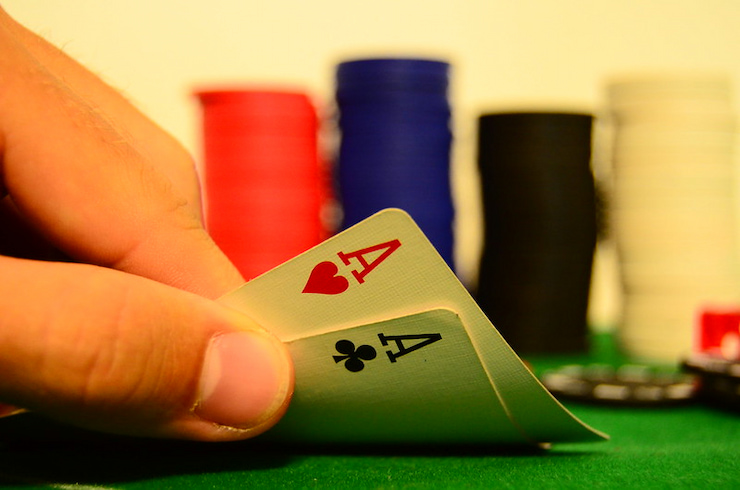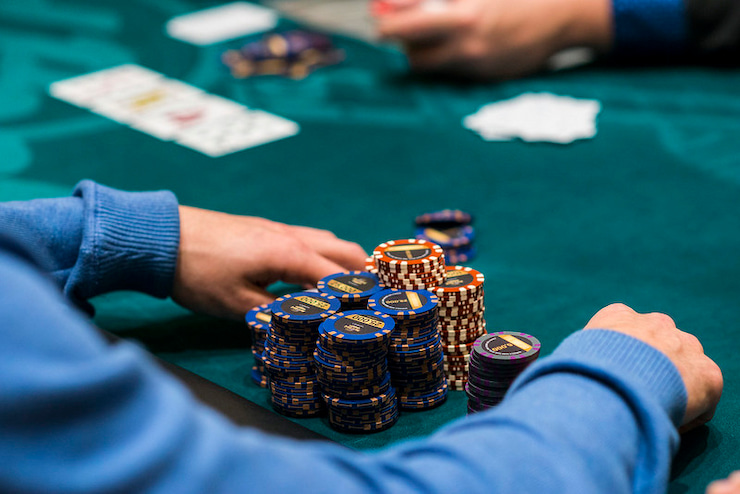Being dealt a pair is about as good as it can get pre-flop, but knowing how to play pocket pairs means knowing how to make the best starting hands in poker pay.
This is where the pocket pairs strategy comes into play — without it, you won’t be able to take advantage of your fortunate situation.
We will guide you through the common mistakes players make when playing these exciting cards and provide some tips to boost your confidence at the tables.
How to Play Pocket Pairs in Poker
A pocket pair means you’re dealt a pair of cards of the same rank, such as 2♥2♦. They can be of any suit, the rank is all that matters here.
Pocket pairs, even deuces, are often winning cards. The higher the pair, the better its chance of winning at showdown.
Essentially, in being dealt a pocket pair, you have been given a ready-made hand before the flop.
No matter if you’re playing at an online poker site or a live game, played correctly, pocket pairs can be some of your biggest money-making hands.
Pocket Pairs Strategies
The first step in knowing how to play pocket pairs in poker is by evaluating their strengths — some pocket pairs are stronger than others.
Knowing things like the odds of getting pocket aces will help with this. Once you have fully evaluated the power of your hand, you will need to know the best betting strategy to use.
This can differ depending on the stage of the round you’re in: a good pocket pairs pre-flop strategy differs from a post-flop one, for example.
Even with these pocket pairs tips, there are pitfalls to be aware of — played wrongly, pocket pairs can be no better than the worst hand in poker. Ignoring your position, stack size, or overvaluing your cards can all bring a great hand undone. This is where we will help you to make the most of your pocket pairs.
Evaluate Your Pocket Pair Strength
It is important to know that there are 13 different Texas Hold’em pocket pairs, ranging from the lowest 2s up to the elusive pocket aces.
The odds of being dealt pocket pairs are just under 6%, and this goes down to 0.45% for the odds of getting pocket aces (or any unique pocket pair). This works out as receiving any pocket pair once in every 17 hands or so, and pocket aces once in every 220 hands.
Pocket pairs can be categorized as premium, medium, and small. Although generally set, hands can be categorized differently, depending on the position you’re in and the stage of the game you’re at. For example, pocket nines are a medium pair in early position but if it folds to you in the small blind, pocket nines is a far stronger hand.
Being aware of this and other pocket pairs tips will set you apart from your opponents.

Premium Pocket Pairs
Premium pocket pairs are a matching set of face cards. These are: A♣A♠, K♥K♦, Q♠Q♣, and J♦J♥.
These are the best pocket pairs in poker. If you are dealt these at any top poker app, the best strategy is to bet them strongly pre-flop. You don’t even need to consider your position the majority of the time.
Ideally, you want to get to a heads-up situation on the flop, to protect yourself from any lower pairs or random two cards outdrawing you when the flop, turn or river cards are dealt.
Being dealt pocket aces is the best possible starting hand — make sure you extract maximum value from them by playing them aggressively and confidently.
Medium Pocket Pairs
Medium pocket pairs are the cards immediately below the face cards: 10♦10♥, 9♥9♠, 8♣8♦, 7♥7♦, 6♠6♣.
Some players may categorize a pocket pair of 10s as a premium pair and 66 as a low pair, but our classification is the generally accepted one.
The objective with medium pocket pairs is to get to the flop and make sets. These hands will also, often times, be strong enough on their own to win at showdown against one or two opponents.
Your pre-flop strategy depends on your position. The best pocket pairs pre-flop strategy for medium pairs, often times, is to either open the action or call vs an early-position raise.
Calling even sizable raises pre-flop is encouraged here as you want to be able to see the flop. Many of these hands may want to raise against a middle-to-late position open to take control of the pot, potentially get overcards to fold, or, at the very least, to thin the field.
Small Pocket Pairs
Small pocket pairs are all of the remaining combinations of paired cards: 5♥5♦, 4♣4♠, 3♠3♥, 2♦2♣.
The plan with small pocket pairs is to try and get to the flop as cheaply as possible. This means if you are in an early position, you should be prepared to fold these cards to any sort of raise. In fact, in early position, you should even fold these cards a majority of the time, even with no prior action, especially if you’re short-stacked.
If you are in a late position, you can call a raise in the hope of making a set, also known as three of a kind. But be aware, this only happens in around 12% of cases.
You can raise small pocket pairs yourself if in a late position, but this raise needs to be big, or you risk the chance of your opponents calling and making a hand or a draw on the flop.
If on the flop you don’t land the set you were hoping for, don’t panic. You should mostly just play passively and fold, losing a minimal investment. A common mistake is for players to make a bluff with pocket pairs here and land themselves in deep trouble.
When to Raise, Call or Fold
You’ve been dealt pocket pairs, and you need a solid pre-flop pocket pairs strategy to match. Whether you raise, call, or fold depends on some key factors: the strength of your pocket pair, the position you’re in, and the moves your opponents make.
For the best pocket pairs in poker — such as the premium pairs — you should always raise before the flop, and call any of the raises, potentially even re-raising. Your hand is too good to throw away at this stage.

In some cases, a good pocket pairs strategy would be to only call when holding either Q♣Q♠ or J♥J♦, in the hope that the flop would bring low cards. You could then bring in more money as your hand has essentially been disguised — not many players could accurately predict that you’re sitting on a premium pocket pair.
This is an advanced play, and could pay off at soft online poker sites, but newer players are better off simply raising.
When holding medium pocket pairs the aim is always to see a flop, as this is where your medium strength hand can have the potential to turn into a premium one. This means calling bets to make sure that you see the community cards.
If calling would virtually put you all in, you will have to think carefully — if your opponent has unsuited high cards, such as A♦K♠, your pocket 8s have around a 50/50 chance of winning. If they have a higher pair, then these odds diminish significantly, as you’ll lose roughly four times out of five.
Re-raising, however, would turn your hand into a bluff with pocket pairs. This is because any opponent raising pre-flop is most likely to have a strong hand, and as we know, you only have a medium one.
For small pocket pairs, you should be ready to fold your cards to any raise from the other players. If you feel that the raise is small enough to call and see a flop, then feel free to do so. But remember, hitting a set on the flop doesn’t happen 88% of the time.
If you are one of the last to act from your late position, and there isn’t much betting action, a big bet can scare off any others who may want to join the round cheaply. Getting to the next stage with as few opponents in as possible will help you make an informed decision.
Post-flop Scenarios and Strategies
The flop has come down, and you have your pocket pairs in hand. But what next?
Mistakes to Avoid with Pocket Pairs
As we previously stated, pairs are some of the most exciting hole cards to get. But this doesn’t mean that they are invincible.
Many players fall into the trap of betting them strongly pre-flop, not hitting a set or a draw on the flop, turn or river, continuing to bet to try and make their opponents fold, and ultimately losing. Don’t let this be you!
Overvaluing Small Pocket Pairs
Overvaluing small pocket pairs is a sure-fire way to come unstuck. Remember that a small pocket pair only has value when you see the community cards and make a set.
If the betting is strong pre-flop, it is better to stay out of the action and fold so as not to bleed unnecessary chips.
If you can’t get to the flop cheaply or against a small number of players, then our advice would be to stay out of the hand.
Ignoring Position and Stack Sizes
Pocket pairs have different values depending on what poker positions you receive them in. Although having premium pocket pairs means that you have a strong hand no matter what position you play them from, for all other pocket pair combinations position is key.
The most important thing to bear in mind is that acting from an early position means that you won’t have information — and information is everything.
For example, if you raise with a low pocket pair from an early position, you leave yourself vulnerable to re-raises or calls. More players in the round means less chance for you, as a low pocket pair is statistically a low-strength hand.
Conversely, if you are on the button, you will have seen how everyone else has played their cards. You will get to decide whether to stay in the hand or not. Calling a small bet at this point so you can see the flop is not a bad choice — you never know, you might land the set you need. Ignore your position at your peril!

Stack size will also influence how you play your pocket pairs, so pay attention to how many chips you and your opponents have.
At the beginning of a tournament you will have a healthy stack, and so either flatting or opening could form part of an effective poker strategy. Any poker coaching sites worth their price would tell you the same.
However, if your stack is dwindling and you’re one of the first to act, and you’re holding small pockets, that would be the time to either raise all-in or fold.
The worst case scenario would be calling to see the flop, not hitting the set and then folding away a healthy chunk of your total — don’t make this mistake.
On the other hand, if you have medium or premium pocket pairs then you can use your stack size to ensure other weaker hands are not limping into the action. By raising strongly, you are eliminating the prospect of players with smaller stacks hitting strong hands, and then going all in.
Conclusion
Having pocket pairs can be both a blessing or a curse. Played well, and with a slice of good fortune, you can seriously bolster your stack and set you on the course to victory.
But playing them badly can have the opposite effect: you can lose a significant amount of your total or prematurely bow out of the game.
The best pocket pairs strategy relies on knowing different pocket pair strengths and how to play them. Study our pocket pairs tips to feel confident at the tables when you get dealt pocket pairs.
Finally, don’t fall into the same traps as countless other players have done, by ignoring your position or stack size, as they have a bearing on your gameplay. Have fun trying out our time-tested strategies at the tables and fingers crossed for pocket aces!






